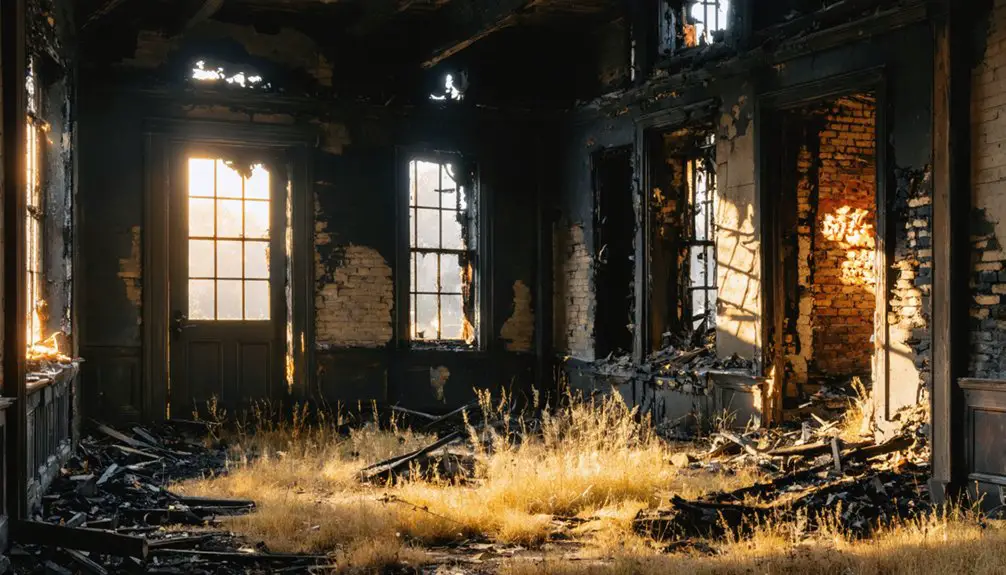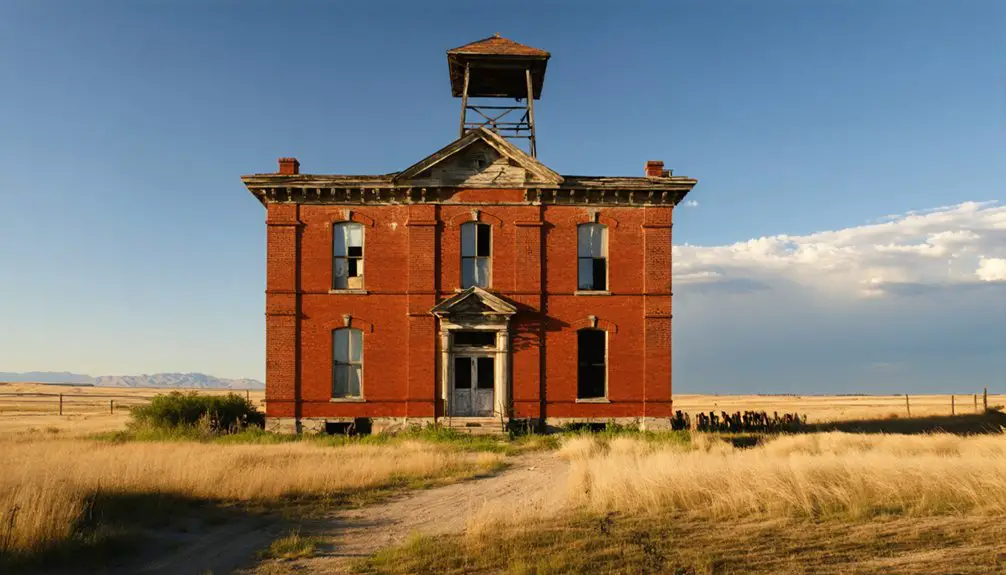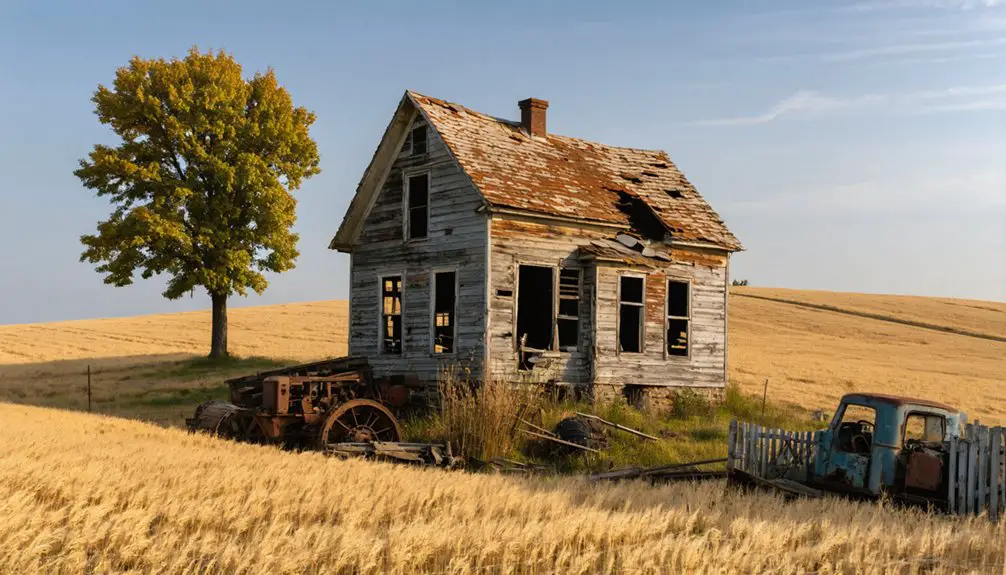You’ll find Govan as a haunting ghost town in Lincoln County, Washington, where a once-thriving railroad community met its dramatic end. Founded in 1889 as a bustling grain shipping hub, the town’s dark history includes unsolved ax murders in 1902 and a devastating fire in 1927 that caused $100,000 in damage. Today, only three residents remain among the weathered ruins, including the iconic 1905 schoolhouse. The town’s tragic past holds even deeper secrets.
Key Takeaways
- Founded in 1889 as a railroad town, Govan thrived with stores, banks, and grain shipping before declining into a ghost town.
- The brutal unsolved 1902 ax murders of Judge Lewis and his wife marked a dark chapter in Govan’s history.
- A devastating 1927 fire caused $100,000 in damage, destroying vital infrastructure and accelerating the town’s decline.
- By 2019, the population dwindled to just three residents, with most buildings abandoned except for a seasonal grain elevator.
- The abandoned two-room schoolhouse, built in 1905, remains a prominent landmark attracting photographers and ghost hunters.
The Birth of a Railroad Town (1889-1902)
Three significant events in 1889 marked the birth of Govan, Washington: the establishment of a railroad depot along the Central Washington Railway, the creation of its first post office, and the naming of the town after R.B. Govan, a Northern Pacific civil engineer.
Founded in 1889, Govan emerged from a railroad depot, post office, and namesake R.B. Govan’s engineering legacy.
You’ll find the railroad’s significance grew exponentially in 1890 when Wood, Larson & Company discovered a massive sandbank nearby, establishing their headquarters to extract materials for railway construction.
The town’s strategic location between Wilbur and Almira, combined with its natural resources, sparked remarkable community growth. By 1898, the population had reached nearly 80 residents, and the post office moved from the depot to a merchandise store. The company employed numerous workers to operate steam shovels and gravel trains for sand extraction. The bustling community soon supported two general stores and various other businesses including a hotel, bank, and restaurants.
As agriculture flourished, Govan transformed from a construction hub into an essential shipping point for grain and produce.
Murder Mystery: The Dark Chapter
While Govan’s early years showed promise as a bustling railroad town, the community’s destiny took a dark turn in December 1902 with the brutal ax murders of Judge J.A. Lewis and his wife in their home.
The murder motives pointed to robbery, as the Judge was known to keep substantial cash on hand. Despite investigations, the killers were never caught.
The darkness didn’t end there. In 1941, another gruesome chapter unfolded when a mother and son were murdered on their farm.
The son’s body wasn’t discovered until 1949, deepening the mystery. You’ll find these unsolved mysteries, along with a mass shooting at the Govan Saloon in 1903, have left an indelible mark on this Washington ghost town.
These violent events contributed to Govan’s eventual decline and haunting reputation. The Central Washington Railway brought initial prosperity to the town in 1889, but the once-thriving community with its post office and schoolhouse gradually faded into obscurity.
Life Along the Tracks: Community and Commerce
If you’d visited Govan in its early days, you’d have found a bustling railroad depot established in 1889 by R.B. Govan, where steam engines thundered past local merchants loading wheat and fruit bound for Spokane’s markets.
A thriving grain shipping hub emerged after the discovery of a massive sandbank in 1890 brought significant growth to the area. The town’s commercial district grew to include two general stores, two hardware stores, a drugstore, and other crucial businesses serving over 100 residents by 1909. The State Bank of Govan provided essential financial services while Pacific Telephone and Telegraph kept the community connected to the wider world.
Farmers from the surrounding region made regular trips into Govan to sell their grain at the depot and shop at local establishments, creating a significant hub of commerce along the Central Washington Railway line.
Railroad Depot Origins
As the Central Washington Railroad expanded its reach in 1889, the small settlement of Govan emerged as an essential railroad depot, named after R. B. Govan, a Northern Pacific construction engineer.
You’ll find the railroad’s significance woven into every aspect of Govan’s early development, transforming it from a quiet ranching area into a bustling transportation hub. The discovery of a valuable sand bank in 1890 accelerated the town’s growth into a thriving boomtown.
- The depot housed the town’s first post office, centralizing mail service
- Daily trains delivered essential goods and connected residents to the wider region
- Local farmers gained direct access to ship their grain and fruit by rail
- The station served as the heart of community transformation, spurring growth that would eventually support 80 residents
This strategic location along the tracks set the stage for Govan’s rapid development from wilderness to civilization.
Merchants and Market Days
The railroad’s arrival sparked a vibrant merchant community in Govan, transforming the depot settlement into a thriving commercial center by 1898.
You’d find merchant stories woven throughout the town’s roughly 80 residents, with Almon J. Smith’s general store and post office serving as a cornerstone of daily life.
Local market traditions centered around the bustling grain and fruit trade, with warehouses and elevators dotting the landscape.
You could shop at two hardware stores, visit the drugstore, or satisfy your sweet tooth at the candy shop.
The town’s two restaurants and saloon created social hubs where you’d catch up on local happenings.
By 1909, a bank helped facilitate commerce, while churches and a school anchored community life.
Sadly, these merchant legacies faded after fires and the 1933 highway bypass diverted traffic elsewhere.
Farming Community Connections
Life along Central Washington Railway‘s tracks shaped Govan’s farming community, transforming it from a sheep and cattle settlement into a bustling grain and fruit producer by the late 1880s.
You’d find strong community bonds woven through every aspect of daily life, from shared church services to commerce at local merchants.
The agricultural heritage that defined Govan’s spirit manifested in four key ways:
- Farmers relied on each other during market days at the grain elevator.
- Methodist and Presbyterian churches served as social anchors for rural families.
- Local stores and the hotel became gathering spots for trading news and goods.
- The schoolhouse brought farming families together through community events.
The railway didn’t just move crops – it connected neighbors, strengthened relationships, and built lasting ties among Govan’s resilient farming folk.
This vibrant community life continued until the 1927 fire destroyed much of the business district, forever changing the town’s character.
Flames and Fate: The Great Fire of 1927

During one devastating night in 1927, flames engulfed Govan’s bustling business district, causing approximately $100,000 in damage and forever altering this small Washington town’s destiny.
You would’ve witnessed the destruction of nearly everything: warehouses, the grain elevator, Northern Pacific depot, stores, post office, hotel, church, homes, and wheat-filled freight cars.
The fire aftermath left Govan without critical infrastructure, including its water tower and gas pump.
Left paralyzed by the fire’s destruction, Govan lost its vital lifelines – the towering water supply and sole fuel source.
While some services adapted – like the Bagley family providing temporary gas sales and a new hilltop cistern for water – the economic impact proved insurmountable.
Most businesses chose not to rebuild, and by 1940, only the Govan General Store remained.
This catastrophic event marked the beginning of Govan’s transformation from a thriving farming community into the ghost town you’ll find today.
The town’s final decline was sealed when the post office closed in 1967.
The Final Days: Highway 2 and Decline
As U.S. Route 2 carved its path through Washington State in 1933, bypassing the once-bustling town of Govan, it marked the beginning of the end for this railway community.
The highway’s impact triggered a devastating economic shift that would transform Govan into the ghost town you’ll find today.
The changes that sealed Govan’s fate were profound:
- Local businesses lost significant railroad customers as automobile travel became dominant
- Farmers relocated to larger markets now easily accessible by highway
- The post office and final merchants closed their doors by 1967
- Population dwindled to just three residents by 2019
While the 1927 fire had wounded Govan, it was the highway bypass that delivered the fatal blow, leaving only the haunting shells of the schoolhouse and other structures as silent witnesses to its decline. The eerie atmosphere is heightened by the legacy of the brutal axe murders that shook the town in 1902, forever staining its history.
Standing Sentinel: The 1905 Schoolhouse

The two-room red schoolhouse stands as Govan’s most enduring landmark, constructed in 1905 to serve the town’s growing population.
For 37 years, two teachers educated local children within its walls, including Anna Evers who taught there in the 1920s.
You’ll find this rural schoolhouse designed in typical early 20th-century architectural style, though its once-proud steeple collapsed in 2019.
The building’s haunted history draws paranormal enthusiasts who explore its abandoned halls, searching for connections to Govan’s unsolved murders.
While the school’s educational legacy ended in 1942 when it merged with Wilbur schools, the structure remains a powerful symbol of the community’s past significance.
Today, you’ll see this weathered sentinel standing alone, silently watching over what remains of the ghost town.
Echoes of the Past: Modern Day Govan
You’ll find most of Govan’s buildings stand empty and deteriorating today, with only a handful of residents remaining in this once-bustling railway town.
The grain elevator still operates during harvest season, while photographers frequently visit to capture the haunting remains of the 1905 schoolhouse and other abandoned structures that dot the landscape.
Despite its ghostly atmosphere, the few occupied homes provide a stark contrast to the surrounding decay, reminding visitors that this Washington ghost town still maintains a tenuous connection to the present.
Abandoned Buildings Stand Watch
Standing sentinel across Govan’s wind-swept landscape, several original buildings remain from the town’s heyday, though most have succumbed to decades of decay.
You’ll find the 1905 schoolhouse dominating the scene, its deteriorating walls drawing photographers and ghost hunters seeking abandoned structures and ghostly encounters.
Experience Govan’s haunting remnants through these surviving structures:
- The iconic schoolhouse, closed since 1942, now stands as an unofficial gathering spot
- A still-operational grain elevator that hums to life during harvest season
- The weathered post office building, evidence of busier times
- Scattered houses, some abandoned and others still occupied, creating a stark contrast
These buildings tell silent stories of the town’s dramatic past, from the devastating 1927 fire to unsolved murders that once shocked this small community.
Current Resident Experiences
Living among Govan’s scattered ruins, modern residents maintain a quiet existence that bears little resemblance to the town’s bustling past.
You’ll find just a handful of occupied homes where neighbors navigate everyday challenges of rural isolation. Without local stores or services, you’ll need to venture to nearby towns for basic supplies.
Life here means staying vigilant around deteriorating structures and old farm equipment while tending to the surrounding wheat fields that still define the landscape.
Current resident stories often intertwine with the town’s darker history of unsolved murders and devastating fires, drawing curious visitors and ghost town enthusiasts.
Despite the isolation, you’ll discover a resilient spirit among those who’ve chosen to remain, their presence keeping Govan from completely fading into history.
Photographers Document Decay
While Govan’s ghostly ruins steadily succumb to time, photographers from around the world flock to this remote Washington hamlet to document its haunting decay.
The decay aesthetics of the abandoned schoolhouse, with its fallen cupola and weathered red exterior, draw urban exploration enthusiasts seeking to capture this vanishing slice of railway town history.
If you’re planning to photograph Govan’s atmospheric ruins, here’s what you’ll find:
- Natural lighting opportunities are best during June and late summer
- Dramatic contrasts between vibrant wheat fields and deteriorating structures
- Textural details including rust, splintered wood, and broken glass
- Unique angles available through careful navigation of the post office and schoolhouse remains
You’ll discover why photographers choose vintage-style cameras like Holgas to enhance the ghostly ambiance of this fascinating destination.
Frequently Asked Questions
Is It Legal to Visit and Explore Govan’s Remaining Buildings?
Like a Wild West outlaw, you’ll need permission since ghost town regulations protect private property. You shouldn’t enter buildings without authorization, as Washington’s historical preservation laws and trespassing statutes apply.
How Many People Currently Live in Govan Year-Round?
Based on current population trends and town history, you’ll find just 3 year-round residents maintaining homes in what’s left of this once-bustling railroad community that peaked at 114 people in 1909.
Are There Any Documented Paranormal Experiences in Govan?
While ghost sightings and local legends abound, you won’t find official documentation of paranormal experiences – though many visitors claim they’ve felt uneasy around the old schoolhouse and murder sites.
Does the Grain Elevator Still Operate During Harvest Season?
No, you won’t find the grain elevator operating during harvest season anymore. It’s been abandoned and deteriorating for decades, joining other derelict structures in the area since Govan’s economic decline.
What Happened to the Bodies of the Unsolved Murder Victims?
You’ll find few traces of the murder investigation victims today – Judge Lewis and wife, C.S. Thennes, and the Lesnetts lack marked graves or memorials. Their bodies’ final locations remain largely unknown.
References
- https://1027kord.com/eastern-washington-ghost-town-govan/
- https://stateofwatourism.com/ghost-towns-of-washington-state/
- https://www.youtube.com/watch?v=ZdEcAblBVVA
- https://www.onlyinyourstate.com/state-pride/washington/govan-ghost-town-wa
- https://www.sunset-hwy.com/govan.htm
- https://thewaywardjournal.substack.com/p/ghosts-of-govan
- https://www.inlander.com/culture/govan-wash-a-railroad-put-this-lincoln-county-community-on-the-map-but-a-1927-fire-set-its-demise-in-motion-28851234
- http://www.bigbendrailroadhistory.com/2008/12/history-of-govan.html
- https://washingtonstate.fandom.com/wiki/Govan
- https://andyporterimages.com/govan-schoolhouse-wilbur-washington/



